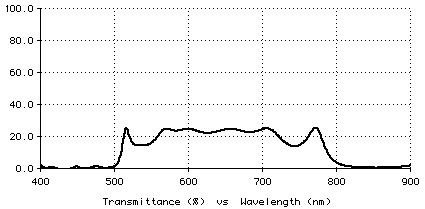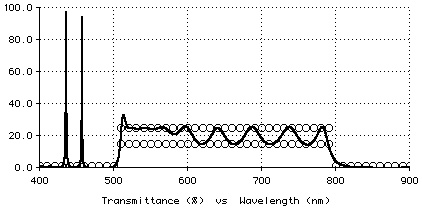Dielectric Sunglasses
A. Transmittance < 1% for wavelengths 400-500 nm
B. Transmittance between 15 and 25% for wavelengths 510-790 nm
C. Transmittance < 1% for wavelengths 800-900 nm
The two coating materials are SiO2 and TiO2 on a glass substrate. Requirements A-C are entered as four continuous optimization targets; there is no need for the designer to decide where to place the individual targets -- TFCalc decides on the number and placement of the optimization targets.
Starting with a single thin layer of TiO2, the needle/tunneling method created (automatically) a sequence of optimal designs of increasing complexity. The ninth optimal design is a 29-layer coating whose performance is shown here.


TiO2 69.95
SiO2 32.82
TiO2 32.68
SiO2 111.15
TiO2 106.07
SiO2 93.12
TiO2 28.13
SiO2 69.00
TiO2 57.75
SiO2 172.27
TiO2 60.40
SiO2 94.82
TiO2 50.14
SiO2 73.58
TiO2 44.78
SiO2 90.29
TiO2 27.17
SiO2 59.58
TiO2 62.56
SiO2 113.66
TiO2 68.53
SiO2 189.07
TiO2 63.17
SiO2 129.47
TiO2 110.55
SiO2 123.90
TiO2 73.89
SiO2 32.41
TiO2 21.12